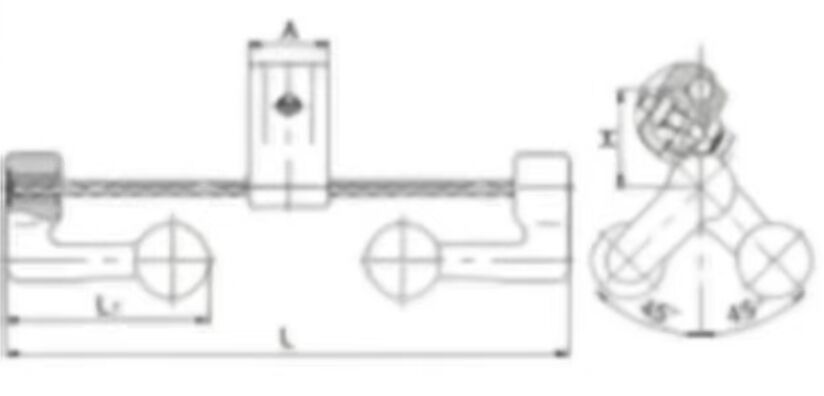1. Unique Structure
The hammer heads are shaped like eccentric eggplants and installed opposite each other on the steel strands at both ends of the clamp. A pre-torque is generated as the hammer heads form a 60° angle with the clamp, which is why it is also called a torque shock absorber. This innovative design enhances energy dissipation by utilizing both translational and torsional vibrations, providing superior damping performance compared to traditional linear dampers.
2. Excellent Frequency Characteristics
It can achieve three natural vibration frequencies, offering a wide frequency coverage range that effectively adapts to different conductor vibration conditions. This multi-frequency capability allows it to suppress conductor vibrations across various wind-induced frequencies, making it suitable for complex meteorological environments and multi-span line structures.
3. Material Composition
Typically composed of galvanized cast iron hammer heads, hot-dip galvanized steel strands, aluminum alloy clamps, and stainless steel bolts, it combines high strength, toughness, and corrosion resistance。
1. Superior Vibration Damping Performance
When the conductor vibrates, the torque-weight hammers subject the steel strands to bending moments and torsional forces, more effectively dissipating the vibrational energy of the overhead line. Compared to some traditional shock absorbers, this design significantly improves vibration damping performance, reduces the intensity of aeolian vibrations, and protects the overhead line by minimizing fatigue stress caused by long-term oscillations.
2. Easy Installation
Some FDZ shock absorbers using preformed strand installation can be installed manually without tools, offering a convenient and rapid setup process. This not only reduces construction costs but also allows for easy visual inspection of installation quality, simplifying project acceptance and lowering associated costs. The tool-free installation feature is particularly advantageous for high-altitude operations or hard-to-reach areas, enhancing construction efficiency and safety.
1. Vibration Energy Dissipation
Installed on overhead lines, when the conductor vibrates due to wind or other factors, the inertia of the heavy hammer causes internal friction in the steel strand, dissipating the conductor's vibrational energy. Meanwhile, air damping on the hammer and energy dissipation/reflection at the clamp further reduce conductor amplitude, protecting the conductor, fittings, and insulators from damage caused by continuous vibration. This multi-mechanism energy dissipation effectively mitigates fatigue stress and mechanical wear.
2. Line Protection
By effectively suppressing line vibrations, it reduces the risk of fatigue damage caused by repeated bending of the conductor at suspension points, extending the service life of the line. This results in lower maintenance costs and fewer power outages due to vibration-related failures. The shock absorber's ability to minimize stress on critical components ensures the long-term reliability of overhead transmission systems, particularly in high-wind or multi-span line segments.

| Model | Applicable twisted wire section(MM) | ALL SIZE(MM) | Singleweight ofthe hammer head(KG) | |||
| A | H | L1 | L | |||
| FDZ-1 | 35-50 | 50 | 60 | 120 | 330 | 0.7 |
| FDZ-2 | 70~95 | 50 | 60 | 130 | 350 | 0.9 |
| FDZ-3 | 120~150 | 55 | 65 | 150 | 430 | 1.7 |
| FDZ-4 | 185-240 | 55 | 65 | 160 | 470 | 2.1 |
| FDZ-5 | 300-500 | 60 | 90 | 180 | 520 | 3.0 |
| FDZ-6 | 500~630 | 60 | 90 | 196 | 550 | 3.6 |
| All measurements provided are manually obtained and may contain slight tolerances. Final dimensions shall be subject to the physical product. | ||||||
Our professional sales team are waiting for your consultation.